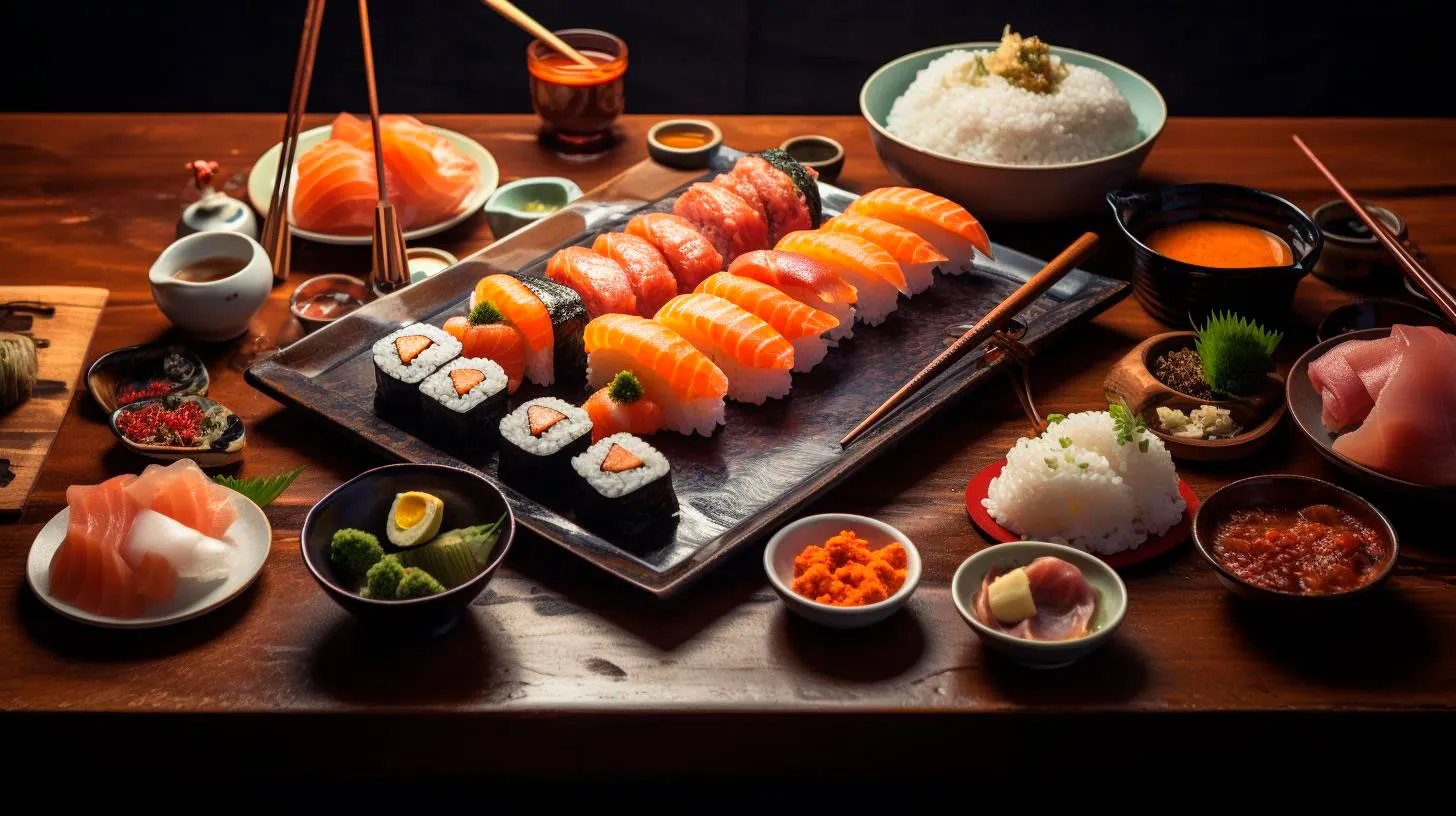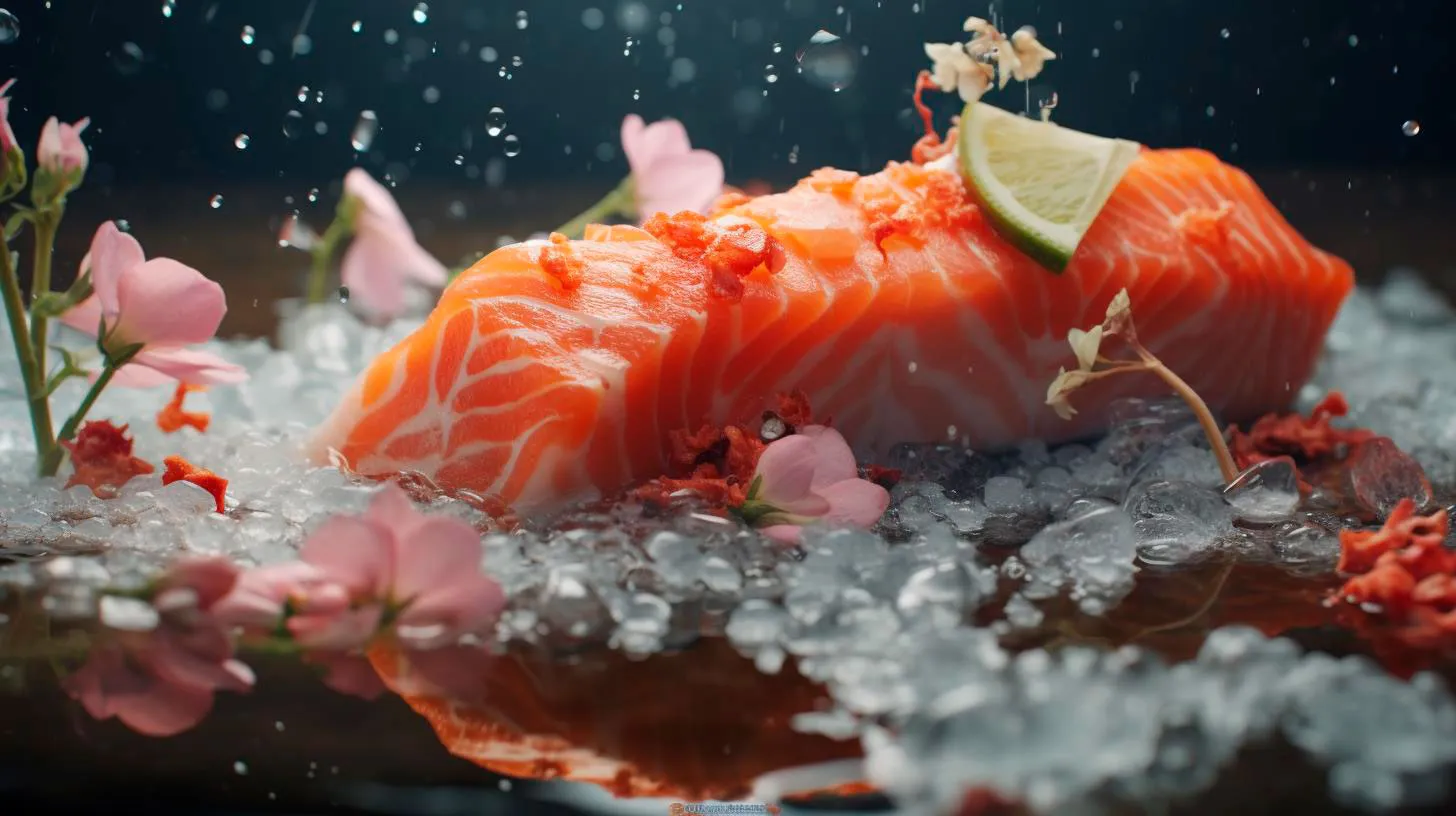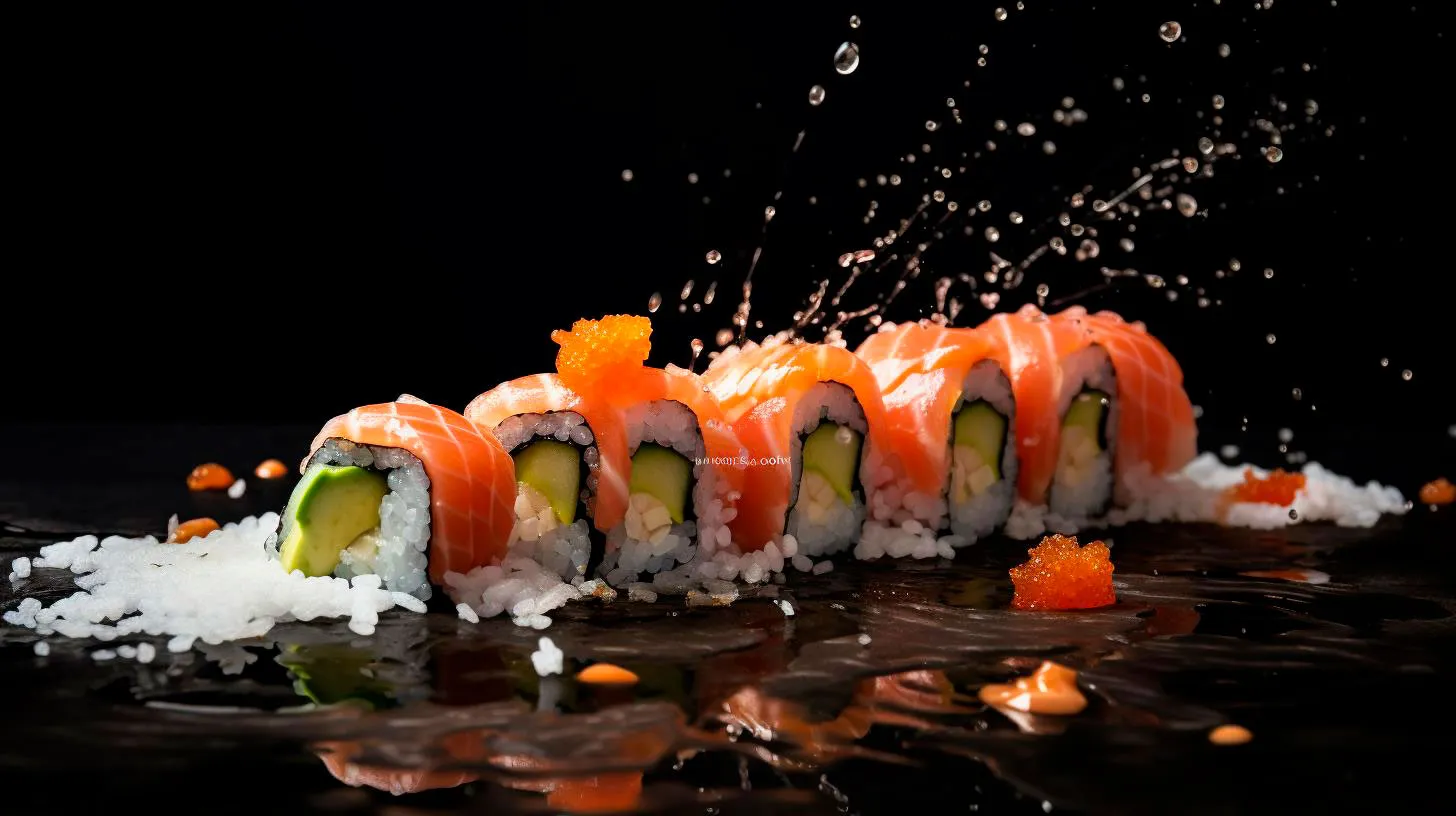Elevating Sushi to Art: Exploring the Intersection of Culinary and Visual Arts
This unique blend of the culinary and visual arts has captured the attention of food enthusiasts and artists alike, resulting in a fascinating amalgamation of flavors and aesthetics.
The Art of Sushi
Sushi making involves a sublime combination of skill, precision, and creativity. From selecting the freshest ingredients to mastering the art of cutting and arranging them with precision, sushi chefs meticulously craft these bite-sized masterpieces. The delicate balance of colors, textures, and flavors is an art form in itself. But what elevates sushi to a whole new level is the presentation.
The presentation of sushi is thoughtfully designed to engage the diner’s senses. The careful arrangement of ingredients, vibrant colors, and intricate details all contribute to the visual appeal of each plate. Every sushi roll, nigiri, or sashimi dish is like a canvas; it is the chef’s artistic expression brought to life. This attention to detail not only enhances the dining experience but also transforms sushi into an aesthetic masterpiece.
Visual Aesthetics and Culinary Delight
When sushi is transformed into a visually appealing dish, it becomes more than just food. It captivates your eyes and entices you to indulge in a sensory adventure. Each plate presents an opportunity for the chef to showcase their creativity and technical skill. By incorporating various colors, textures, and arrangement techniques, sushi chefs can create visually stunning presentations that enhance the overall dining experience and leave a lasting impression.
Key takeaways:
The Fusion of Culinary and Visual Arts
The intersection of culinary and visual arts stretches beyond the presentation of sushi. Talented sushi chefs often collaborate with artists, photographers, and designers to enhance the overall visual experience. Through collaborations, they blur the lines between these two art forms, resulting in breathtaking culinary creations that are as visually appealing as they are delicious.
Sushi fusion is another example of how the culinary and visual arts intertwine. By combining various ingredients, flavors, and cultural influences, sushi chefs create innovative dishes that break traditional boundaries. These fusion creations are not only visually captivating but also offer a unique gastronomic adventure, blending traditional and contemporary flavors to cater to diverse palates.
Elevating Sushi’s Visual Appeal
The surge in social media and food photography has further elevated the visual aesthetics of sushi. With platforms like Instagram becoming havens for visual storytelling, sushi’s intricate artistry has found a digital stage to shine. Sushi chefs and food enthusiasts now share their visually stunning creations with the world, influencing and inspiring others to explore the art of sushi making.
Key takeaways:
Sushi as a Culinary Journey
Sushi, when viewed as an art form, transforms a simple dining experience into a captivating culinary journey. Each piece of sushi offers a story – a unique blend of ingredients, flavors, and textures that tantalizes the taste buds. From the first bite to the last, sushi takes the diner on an exploration of taste, aesthetics, and cultural traditions.
The artistic presentation of sushi compels us to savor not only the flavors but also the craftsmanship and dedication behind each creation. It invites us to appreciate the beauty of food as an art form and cultivates a deeper connection between the diner, the chef, and the cultural heritage from which sushi originates.
Embracing Sushi as Art
As sushi continues to captivate both culinary and art enthusiasts worldwide, it demonstrates the extraordinary ability of food to transcend its primary purpose. Sushi’s elevation to art challenges our perceptions and provides a platform for innovation, cultural exchange, and creative expression. By embracing sushi as art, we open ourselves up to a world where culinary and visual arts blend seamlessly, creating experiences that are not just meals, but artistic masterpieces.
Key takeaways:
In conclusion, sushi’s transformation from a culinary creation to an art form is a testament to the ingenuity and creativity of sushi chefs. By skillfully combining the culinary and visual arts, they have elevated sushi into an experience that tantalizes not only the taste buds but also the eyes. Sushi’s fusion of flavors and aesthetics has become a visual symphony of culinary delight, presenting us with an opportunity to indulge in both gastronomic and visual pleasures simultaneously.
From Plate to Masterpiece: Unveiling the Seamless Blend of Culinary Skills and Fine Arts
Let’s explore the seamless blend of culinary skills and fine arts, and how it is revolutionizing the way we experience food.
The Culinary Canvas: A New Frontier
Chefs are no longer confined to the boundaries of a plate; they are now exploring beyond the kitchen to create visually stunning dishes that resemble pieces of art. Each plate becomes a blank canvas for them to showcase their imagination and talent. The marriage of culinary skills and fine arts allows for a multidimensional experience that engages not only the taste buds but also the eyes, creating an unforgettable dining experience.
When creating their masterpieces, chefs carefully consider elements such as color, texture, plating techniques, and overall presentation. They draw inspiration from various art forms, including paintings, sculptures, and even architecture. By incorporating these artistic elements into their dishes, chefs elevate food from a mere necessity to a form of artistic expression.
Key Takeaway:
- The integration of culinary skills and fine arts enables chefs to create visually stunning dishes that are not only delicious but also aesthetically pleasing.
Personalization: A Reflection of the Chef’s Craftsmanship
Just as artists infuse their creations with their unique style and emotions, chefs add a touch of their personality to every dish they create. The fusion of culinary skills and fine arts allows chefs to express their creativity and craftsmanship, making each plate a reflection of their culinary expertise.
Every ingredient is carefully selected, and every technique is executed with precision. Chefs aim to evoke emotions, tell stories, and create memorable experiences through their culinary art. By adding their personal touch, chefs can showcase their culinary mastery and leave a lasting impression on diners.
Key Takeaway:
- The seamless blend of culinary skills and fine arts allows chefs to showcase their creativity and craftsmanship, making each dish a reflection of their unique style and expertise.
The Rise of Instagram-friendly Dishes
In today’s digital age, where visual content dominates social media platforms, the culinary world has adapted to cater to the trend. Chefs now create Instagram-friendly dishes, which not only taste exquisite but are also visually appealing and shareable. The fusion of culinary skills and fine arts enables chefs to craft dishes that are practically begging to be photographed.
From elaborately plated desserts to colorful and vibrant dishes, chefs are utilizing the power of aesthetics to entice food enthusiasts worldwide. These visually striking creations not only attract attention but also serve as free advertising for restaurants, increasing their online presence and attracting new customers.
Key Takeaways:
- Chefs are creating Instagram-friendly dishes that are visually appealing and shareable, leveraging the power of aesthetics to attract a wider audience.
- Visually striking dishes not only capture attention but also serve as free advertising for restaurants, boosting their online presence and attracting new customers.
Bringing Food and Art Enthusiasts Together
The seamless blend of culinary skills and fine arts has opened up opportunities for collaboration and synergy between the food and art worlds. Events such as food art exhibitions, culinary installations, and cooking demonstrations have become popular, drawing both food enthusiasts and art lovers alike.
These events not only showcase the talents of renowned chefs but also provide a platform for emerging artists to display their work. The synergy between food and art creates a unique and immersive experience that appeals to a diverse audience, fostering creativity, and sparking new ideas.
Key Takeaway:
- Collaboration between the food and art worlds through events and exhibitions offers a unique and immersive experience for both food and art enthusiasts.
A World Where Food Becomes Art
As the seamless blend of culinary skills and fine arts continues to evolve, we can expect to see even more groundbreaking creations emerge from the kitchens of visionary chefs. The convergence of these two disciplines has opened up a world where food becomes art, and every dish tells a story. It is through this fusion that gastronomy transcends its traditional boundaries and becomes a transformative experience for all those who indulge.
So, next time you dine at a restaurant that embraces this fusion, prepare to be amazed not only by the flavors on your plate but also by the culinary masterpiece before you.
The Delicate Harmony Where Culinary Excellence Meets Fine Arts
Exploring the Artistry of Culinary Creations
Just like a painter carefully selects colors and brush strokes to create a masterpiece, a chef uses fresh ingredients, unique flavors, and innovative techniques to craft culinary art. Here are some key elements that highlight the artistry behind culinary creations:
- Meticulous Presentation: A well-prepared dish is not only delicious but also visually stunning. Chefs pay great attention to plating, using various techniques to create visually appealing arrangements that enhance the overall dining experience. From delicate microgreens to artistic swirls of vibrant sauces, every element on the plate has a purpose.
- Balancing Flavors: Just as a painter balances colors, chefs strive to create a harmonious blend of flavors. They understand how different taste profiles interact and carefully combine ingredients to achieve the perfect balance. From sweet and sour to salty and spicy, flavors are orchestrated to create a symphony on the palate.
- Experimentation and Innovation: Like any form of art, culinary creations constantly evolve. Chefs push boundaries, experiment with new ingredients, fusion cuisines, and cutting-edge techniques to deliver unique experiences. Whether it’s molecular gastronomy or reinterpretations of traditional dishes, innovation is the driving force behind culinary art.
Bringing Gastronomy and Fine Arts Together
Throughout history, gastronomy and fine arts have frequently crossed paths, inspiring each other and collaborating to create unforgettable experiences. Here are a few instances where these two realms have merged:
- Fusion Cuisine: The blending of different culinary traditions and techniques is often likened to mixing various artistic styles. Just as artists combine different elements to create something entirely new, fusion cuisine brings together flavors, ingredients, and techniques from different cultures to create innovative and exciting dishes.
- Gastronomic Photography: Food photographers capture the beauty of culinary creations, showcasing them as if they were works of art. Through meticulous lighting, composition, and styling, they create visually captivating images that highlight the artistic side of gastronomy.
- Artistic Food Installations: Artists worldwide have embraced food as a medium for expression. From intricate sugar sculptures to edible installations, these creations blur the line between art and food, capturing viewers’ attention and challenging their perceptions.
The Key Takeaways from This Marriage of Worlds
The harmony between culinary excellence and fine arts offers us endless opportunities to indulge in an extraordinary sensory experience. Here are the key takeaways:
- Appreciating Aesthetics: By understanding the artistic elements behind culinary creations, we can develop a deeper appreciation for the thought and effort that goes into each dish.
- Encouraging Creativity: The fusion of gastronomy and fine arts encourages creativity in both realms. Chefs find inspiration in paintings, sculptures, and music, while artists explore food as a form of expression.
- Delighting the Senses: When culinary excellence meets fine arts, our senses are indulged in a symphony of flavors, textures, and visual delights. This unique combination elevates the dining experience to a whole new level.
In conclusion, the enthralling connection between culinary excellence and fine arts enriches our lives in numerous ways. From imaginative plating techniques to innovative fusion dishes, this harmonious marriage elevates dining experiences to a true art form. So, the next time you savor a delectable meal, take a moment to appreciate the delicate harmony where culinary excellence meets fine arts.
Sushi as Sculpture: A Fusion of Gastronomy and Artistry
Join us on this journey into the world of sushi as sculpture.
The Art of Sushi
Sushi, a traditional Japanese dish, has gained international popularity for its exquisite presentation and delicate flavors. With its origins dating back to the 2nd century AD, sushi was initially a method of preserving fish in fermented rice. Over time, sushi has evolved into an art form that combines the beauty of craftsmanship with the freshest ingredients.
- Gastronomic craftsmanship: Sushi chefs, known as Itamae, undergo years of apprenticeship to master the art of making sushi. From selecting the perfect fish to crafting visually stunning compositions, every step of the process is meticulously executed to create a culinary masterpiece.
- Minimalism and attention to detail: The simplicity of sushi lies in its minimalist approach. Each ingredient is carefully chosen to enhance the flavors and textures of the dish. The attention to detail is evident in the precise cuts, elegant presentation, and subtle seasoning.
- Visual appeal: Sushi is not only a treat for the taste buds but also a feast for the eyes. The vibrant colors of the fresh fish, the contrast of textures, and the artful arrangements on the plate all contribute to the visual appeal of sushi.
The Fusion of Gastronomy and Artistry
Sushi bridges the gap between culinary expertise and artistic expression, intertwining gastronomy and artistry in a harmonious way. Here’s how:
- Creativity in composition: Sushi chefs have the freedom to create unique compositions by combining different ingredients. This allows them to experiment with colors, textures, and flavors, resulting in visually stunning and innovative sushi rolls.
- Immersive dining experience: Sushi is not just about the final dish; it is an immersive experience that engages all the senses. From watching the chef’s skilled hands to savoring each bite, sushi combines the visual, tactile, and gustatory elements to create a memorable dining experience.
- Keeping tradition alive: While sushi has evolved over the years, it still retains its traditional roots. The artistry of sushi lies in preserving the techniques and traditions that have been passed down through generations, ensuring the continuity of this culinary art form.
Key Takeaways
Sushi as sculpture offers a unique gastronomic experience that blends artistry and culinary expertise. Here are the key takeaways from this journey:
- Meticulous craftsmanship: Sushi requires years of training and dedication to master the intricate techniques involved in its creation.
- Simplicity and attention to detail: The beauty of sushi lies in its simplicity, where each ingredient is carefully selected and prepared to perfection.
- Visual delight: Sushi entices both the palate and the eyes, with its visually appealing presentation and vibrant colors.
- Creative expression: Sushi chefs have the freedom to unleash their creativity and experiment with different flavors and textures.
- Preserving tradition: While embracing innovation, sushi cherishes its traditional roots, honoring the techniques and traditions that define this culinary art form.
As the art of sushi continues to evolve, it serves as a testament to the endless possibilities when gastronomy and artistry intertwine. Whether you are a sushi enthusiast or a connoisseur of fine arts, indulging in sushi as sculpture will leave you awe-inspired and craving for more.


